-
PDF
- Split View
-
Views
-
Cite
Cite
David M. Hix, Providing the Essential Foundation through an Experiential Learning Approach: An Intensive Field Course on Forest Ecosystems for Undergraduate Students, Journal of Forestry, Volume 113, Issue 5, September 2015, Pages 484–489, https://doi.org/10.5849/jof.14-065
Close - Share Icon Share
Abstract: Increasingly, the focus for many natural resources professionals is on the forest ecosystem, defined both spatially and temporally to include all of the interacting organisms and their physical environment. The ecological interrelationships among their major components (climate, vegetation, soil, and physiography) must be understood to effectively manage the forest for diverse values and products. Over the past 16 years, I have developed an intensive field-based course using an experiential learning approach. During the autumn semester, the students participate in weekly half-day lab opportunities to collect and quantitatively analyze data from local (meso-scale) forest ecosystem types. Student teams communicate their results in both written lab reports and by sharing and reflecting on them during class discussions that contrast the distinct characteristics of each forest ecosystem type. We have experimented with a variety of student evaluation strategies, e.g., personal course notebooks, to determine the foundational knowledge attained by students. Through many different experiences as part of a learning cycle, students develop indispensable field skills and demonstrate competence by individually performing forest ecosystem assessments. Overall, students in the course have commented that they have appreciated and benefited from these essential experiences and acquired critical sampling, analytical, and evaluation skills and knowledge that they will use in their careers.
Management and Policy Implications: There are certain competencies, as well as knowledge, that forestry and natural resources professionals should possess. It is incumbent on our accredited institutions to instill these essential concepts and skills in students graduating from their undergraduate educational programs. In many situations, a forester must comprehend the basic biological and ecological relationships among the major components of forest ecosystems that they have the responsibility for restoring and managing. They must be able to identify plant species and relate them to critical environmental factors (e.g., soil moisture and landform). While a student, an individual needs to learn these concepts and principles, through both instruction and personal observation and study. Ultimately individuals must know how to apply their knowledge and conduct ecological assessments of forest ecosystems, including sampling and quantifying their compositions and structures. We have found that an experiential learning approach, including a sequence of multiple field experiences, is one of the best ways for students to begin acquiring a foundation on which to build. They must master the techniques of field data collection and analysis, then build confidence through reflection and sharing their ideas, and ultimately apply their knowledge to other forests. As the local (meso-scale) ecosystem increasingly becomes the focus for professionals, foresters with a strong foundation of knowledge and skills will be best able to practice successful stewardship of our forests for the long-term benefit of society.
“Go to nature; take the facts into your own hands; look, and see for yourself!” James (1897, p. 9) quoting Louis Agassiz, Swiss-born US naturalist and teacher who lived from 1807 to 1873
A forest ecosystem can be defined as a three-dimensional area of the Earth that exists at a certain time and includes the above- and belowground environment along with all the organisms that live there (Barnes et al. 1998, Helms 1998). When an ecological approach to the study and management of forest landscapes is taken, the ecosystem is an appropriate conceptual focus as we consider the interrelationships among its major components (e.g., vegetation, soils, and physiography) (Barnes et al. 1982). Rowe (1961) was among the first to recognize the different levels of organization as they apply to the examination of forest ecosystems and later promoted an ecosystem approach to forestland management (Rowe 1992).
Through education and professional practice, a forester will learn to comprehend and interpret the basic ecological relationships among the components of forest ecosystems. Foresters must then be able to use their knowledge of ecological principles and engage others to help effectively address the complex political, economic, and biological forest management issues facing society (Bullard et al. 2014). Silviculture is essentially applied forest ecology (Smith et al. 1997) and redefined by Barnes (1996) as the theory and practice of controlling forest ecosystem structure and function. O'Hara and Nagel (2013) emphasized the appropriateness of managing for within-stand variety of structures while considering stands as both ecological and operational units. Their concept of an ecological stand as a unit for management centers on how the ecosystem was affected by disturbance at a given site and on its climatic, edaphic, and geomorphologic qualities. Thus, our emphasis in forestry increasingly is on forest ecology and the forest ecosystem, rather than just on the trees.
Learning about Forest Ecosystems
Students and educators alike express their desire to focus on active rather than passive learning, and they appreciate the value of field-based courses (Covington et al. 2000, Leslie and Wilson 2009, Griset 2010). Natural resources students have been found to learn better in applied settings and outdoor spaces (i.e., field laboratories) than in classroom environments (Montgomery and Millenbah 2011). During the May 2014 webinar summarizing the key recommendations from the North American Summit on Forest Science Education, the same sentiment was confirmed by the declaration of some participants, “Fieldwork is critical!” (Rick Standiford, University of California–Berkeley, pers. comm., May 7–9, 2014). In a recent survey, forestry employers ranked both “forest ecology” and “plant identification” as among the most important knowledge and skills needed by forestry graduates (Pinchot Institute for Conservation 2014). Despite the barriers and constraints incumbent with planning and conducting field instruction (e.g., logistical, financial, and time commitments), there seems to be recognition of both a great value and need for developing an effective ecosystem-based approach. For these reasons, after a process of curricula review and revision, our forestry program decided to place greater emphasis on experiential learning (Kolb 1984) and in 1999 expanded and improved the field experiences provided for our students.
One of the outcomes our faculty have as an objective for our students is to be able to conduct ecological assessments of forest ecosystems (Zundel and Needham 2000, Society of American Foresters 2014). We know there are key ecological concepts our students need to comprehend about forests as one basis for their management. We decided to focus one particular curriculum on forest ecosystem science and management. Ecological assessments include the measurement and analysis of living and nonliving ecosystem components and the interpretation of their spatial and temporal interrelationships, especially coupled with human systems. We determined that through a new course our students should achieve competencies in forest biology and ecology that would include the abilities to sample and quantify the compositions of the major forest ecosystem types of the north-central United States and to explain the fundamental structural, functional, and successional dynamics of temperate forest ecosystems.
A new course entitled “Forest Ecosystems” was designed and taught for the first time in 1999. This undergraduate course emphasizes field-based, experiential learning more so than typical forest ecology courses, as well as that of our own former traditional silvics course. We are committed to an approach wherein students learn how to observe, analyze, and compare local (meso-scale) forest ecosystem types (Barnes et al. 1998), utilizing the quantitative data they collect during weekly half-day field trips. The overarching goal of this course is for students to learn the basic ecology (structure and function) of temperate forest ecosystems through intensive field experiences, as well as by reading and participating in lectures and other indoor sessions. As will be described in the next section, through this series of six field trips during which the student teams conduct the same measurements and analyses each time, they learn how to carefully assess forest ecosystems. Enrollment in the course has ranged from 8 to 22 students and has been rising. The objectives of this article are to explain this experiential learning approach we have used for 16 years to build students' knowledge of forest ecosystems and to evaluate how effective this intensive field course has been as a foundation course for undergraduate forestry and natural resources students.
Approach to the Field Work
Our approach to the fieldwork is based on the theory and principles of experiential learning (Kolb 1984, Kolb et al. 2001). This is an active form of learning through experiences that includes reflecting on personal encounters and applying the lessons learned to future situations. In the process, the learner creates personal knowledge through the transformation of experience (Kolb 1984). The model for the forest ecosystems course can be visualized as an iterative process, with three major steps as described in detail in the following sections (Figure 1). First, during the autumn semester, the students work in teams to learn how to collect quantitative field data about a particular type of forest ecosystem; they begin to master assessment skills and critical reasoning through weekly repetition in new locations. Second, they analyze their data sets and reflect on the distinct characteristics of the forest ecosystems and how each compares and contrasts with other kinds of ecosystems. The third step in this iterative process involves the students' formulating knowledge of the interrelationships of ecosystem components and applying these concepts in new ecosystems. Our student-centered approach has several advantages, including fostering independent thinking, providing real-life connections, and engaging students in the learning process (University of South Carolina Center for Teaching Excellence 2011, as cited in Quesada-Pineda et al. 2011).
Model of the experiential learning approach used to learn about forest ecosystems.
After years of reconnaissance for the field labs, we now have an established network of locations that represent the most prevalent forest ecosystem types in our region. Since 1999, we have worked with local forest managers and landowners to conduct the class's fieldwork. The majority of the forests are located on public land belonging to state agencies and municipalities; some of the forests are designated recreation areas. We primarily study areas that are relatively undisturbed; however, some have been managed for timber in the past (usually at least three decades before the present) and the driest ecosystem types (e.g., south-facing slopes) have experienced fires. The gradient of soil conditions for the forest ecosystem types is from dry to wet (Table 1). Some of the specific variations are based on their landforms and include slopes, ridges, floodplains, and swamps. In each lab, we focus on one or two forest ecosystem types in a particular location, and students practice the appropriate field methods for assessing these types.
From the onset, the main thrust has been for students to investigate the interrelationships among these major ecosystem components: climate, vegetation, soil, and physiography (surface landforms and underlying geologic material). As an example, the first forest ecosystem type examined in the field (Table 1) has dry silty clay loam soil developed in glacial till, the landform is south-facing, moderately steep slopes, and the canopy and regeneration layer are both dominated by white oak (Quercus alba L.). We then follow a progression across the landscape, next focusing on dry-mesic and then mesic forest ecosystem types. After examining these upland ecosystems in detail during the first few weeks, we transition to lowland ecosystems including wet-mesic floodplains and wet swamps. Students reflect on the patterns they observe in the landscape and begin making connections among these ecosystem components, integrating ecological concepts they are learning from field and classroom experiences and from reading assignments. In their final assignment, over a period of several weeks, the students examine the forest at a larger scale. Each team is assigned a large area of forest, usually approximately 20 acres in size. For this study area, the students use the available data layers (e.g., the Web Soil Survey) and the sampling techniques they have learned to examine, describe, classify, and map the forest ecosystem types of the landscape.
Collecting and Analyzing Field Data
In six of the field lab locations (Table 1), teams of three to four students each are assigned the task of sampling permanent plots by observing and measuring the major characteristics of the woody vegetation, soils, and physiography. The permanent plots have been laid out along cardinal directions using a random starting point judged to be somewhat centrally located within a homogeneous landform type (e.g., level upland or lowland floodplain). Later in the semester, students also learn to use belt transects (16.4-ft wide) as a tool for sampling the ecosystems in the landscape and determining boundaries (ecotones) between types. The plots are permanently marked with stakes in each corner and geo-referenced. Each square 0.1-acre plot is sampled in a given year by only one team. Students first learn to sample these fixed-area plots to prepare them to establish temporary plots of the same design later in the semester, using a compass and correcting for slope steepness with a clinometer. For consistency among teams, students enter their data onto class data sheets, and these originals are included as appendixes in their team lab reports. Measuring tapes are laid along the ground to define the boundaries between the corner stakes, making it clear to the team members which plants are definitely located within the plot. Intensively sampling a series of permanent plots is one of their best opportunities to apply concepts and plant identification and taxonomy skills they learned in the prerequisite Dendrology and Forest Biology course, as well as other courses in the curriculum (e.g., Forest Biometrics).
On the entire plot, the emphasis is placed on assessing the woody forest plants (species of trees, shrubs, and vines) (Figure 2). Students learn about the importance of nonwoody species as components of the plant community; because of constraints of the season and students' identification skills, we focus on the woody species and discover how various species indicate the environmental conditions. All trees (≥4.1 in. in diameter at 4.5 ft above the ground [dbh]) are tallied by species and crown class (Barnes et al. 1998), indicating whether the tree is dead or alive. All sapling-size stems are separately tallied into two diameter-size classes: small, 0.1–2.0 in. dbh; and large, 2.1–4.0 in. dbh; living stems are counted separately from dead stems. Time constraints do not allow the teams to accurately inventory the woody regeneration layer (i.e., seedling-size individuals) on the entire plot. Living seedlings are only tallied by species if rooted within the inside 3.3-ft wide strips along all four boundary lines of the plot; little stems (0.1–1 ft tall) are counted separately from the big stems (1.1–4.5 ft tall). Students learn to always stand outside of the plot to avoid trampling the vegetation that they are tallying. Both native and nonnative woody plant species are included in all the fieldwork; the importance of invasive species is stressed. Students use field guides to confirm correct identification of the woody plants; the instructors provide assistance only when necessary and to reinforce proper nomenclature. Woody debris (fallen trees and branches) is also inventoried along all four boundary lines, by counting each stem or piece of wood (≥4.1 in. in diameter at the crossing point) that intersects the plot boundary.
Students sample all the structural layers of forest ecosystems, including the woody plant regeneration.
Most students in the course have taken both our soils lecture and indoor lab courses; in the field they are given opportunities to apply and develop their knowledge by examining representative soil profiles. After excavating a small pit (approximately 30-in. deep), they describe the soil profile by horizon, including depths, textures, colors, mottling, abundances of coarse fragments and roots, and reaction (pH). Parent material(s), the unconsolidated material(s) from which the soil has developed, are also determined, along with drainage class.
The final step in the field is to characterize the physiography (i.e., surface features) represented by the sample plot. Students apply appropriate physical geography concepts and determine the landform, slope steepness, aspect (direction the slope faces), slope shape, slope or topographic position, length of slope, and elevation. In this regard, the students practice field measurement skills including using a clinometer to determine the percent slope and a compass to determine the azimuth of the aspect.
The student teams summarize and analyze their own vegetation data by size strata. Once they have learned the appropriate procedures, the students separately examine the tree, sapling, seedling, and woody debris data sets. Most students come into the course with limited backgrounds and skills with quantitative techniques; through weekly practice and reflection on their results over time they become competent with them. For instance, they learn how to relativize both density and basal area by species for the tree stratum and why these two different measures are important to calculate and then combine into an “importance value.” We carefully separate the stems by crown class and compare the computed values for the different structural layers, i.e., canopy, overtopped (suppressed), and dead trees. Following the same overall scheme, students summarize and analyze the other data sets.
Each student team prepares a written lab report, using the data they collected, that documents their field and quantitative methods, explains the distinctive characteristics of the forest ecosystem type (based on their observations and research), and discusses and speculates on the disturbance history and successional trajectory of the forest stand. The teams then present (share) and discuss their main results in class the following week. The process involves each team using a tabular format to make an oral presentation that highlights the major components of their forest ecosystem type. We have found that by the teams using some consistency in their summary tables, we can effectively contrast the ecosystem types in class, bringing out the major relationships among ecosystem components and learning the particular indicator values of our woody forest plant species. In both their written reports and oral presentations, emphasis is placed on students' developing and mastering communication skills that will be useful in their careers as forestry professionals, including following grammatical rules and writing conventions, properly citing the literature, and effective public speaking. Bullard et al. (2014) also found that these skills were among the top ones identified by the focus groups involved in the process of review of their forestry curriculum.
Applying New Concepts
In the middle of the semester, students must individually perform data collection for and analyses of “new” forest ecosystem types during an exercise entitled, “Ecosystems of Mystery.” They have already had several weekly cycles of studying a range of forest ecosystem types (Table 1), stressing both the field sampling techniques and reflecting and communicating about the characteristics and dynamics of the most common types of local forest ecosystems. Students are taken to a new location, one that has not been used previously for field labs, where they must demonstrate their skills and apply their knowledge to forest ecosystems that are “novel” to them. All of the fieldwork is done on an individual basis and not as a member of a team; e.g., they take turns describing a soil pit that has been excavated for them. For the second individual performance, students sample along a transect (instead of plot sampling) and must successfully characterize the ecosystem types and recognize the ecotones between them.
Besides learning about the compositional and successional dynamics of forest communities of the six particular ecosystem types we focus on, additional labs help the students appreciate how ecological concepts can be applied to their restoration and management. An important process in a forest ecosystem is the dynamics of canopy gaps, which directly affect the successional trajectory of a stand by influencing regeneration development, species composition, and age structure (Barnes et al. 1998). As an example, in one lab we use a modified version of Runkle's (1992) transect method to sample the canopy gap characteristics (e.g., size, origin, and proportion of gaps) of a forest that has been seriously affected by the emerald ash borer (Agrilus planipennis) (Klooster et al. 2014). The student teams use what they learn about the composition and dynamics of the forest ecosystem as a basis for management recommendations to cope with the disturbance and the mortality caused by this insect.
Evaluating Students' Learning
Over the years, we have experimented with a variety of strategies for evaluating individual student learning attainment. In addition to the team lab reports and the Ecosystems of Mystery individual field performances described previously, assessment has been conducted using assignments students complete outside of class, as well as exercises in class, for them to demonstrate mastery of particular concepts. Summative assessment in most years consisted of two midterms and a final examination. About 45% of students' final course grades was determined by their performance on either exams or notebooks (see below), as well as assignments, other exercises, and class participation; the majority of their course grades was based on their performance on the field-based lab work and communicating their findings.
In certain years, students have been allowed to demonstrate their new knowledge related to concepts and sampling of forest ecosystems through composing entries into a personal course notebook or journal. In some years, students were presented an option and asked to vote for either exams or notebooks; using secret ballots students have voted for exams about 60% of the time. Each person's notebook was evaluated for its synthesis of concepts and associations learned from all opportunities, including reading, assignments, exercises, lectures, and lab work.
The instructors also evaluated the students' personal statements concerning how they learned about forest ecosystems, and their expectations about their abilities to apply the sampling skills in the future. One student wrote:
Many students commented that they benefited from the notebook experience, and some stated at the end of the semester that they thought the approach was better than traditional written exams. In a comparison of these two methods of student evaluation, the mean score for students who completed notebooks of 88.9% (SD, 6.0) was significantly higher (P < 0.001) than the score for those who took exams (78.6%; SD, 12.70).Studying forest ecology should try to include as many components as possible, like climate, water, soil, communities, and physiography.
Feedback and Course Assessment
We feel that it is very important to seek feedback from the students, including their opinions of the course and the instruction. Usually students are asked to provide anonymous comments and suggestions midsemester. We then consider their constructive criticisms and ideas, reporting back to the students about potential changes we will institute for the remainder of the semester. The university requires mandatory student evaluation for every course at the end of each semester, with 10 standard, required items. Students are able to again anonymously provide their comments in addition to answering the survey questions, and each instructor receives an electronic report after the conclusion of the semester. On a five-level Likert scale, with “5” indicating the highest level of response, overall this course has been rated very highly by students (range 3.8–5.0) and exceeded the university mean for classes of similar size (i.e., 4.1–4.4) every year except one (2009). In addition, on my invitation, a consultant from the university's Center for the Advancement of Teaching privately conducted midterm, small-group interviews of the students in the class. I learned that students felt that to facilitate their mastery of ecological principles and quantitative methods I should continue to use several approaches: provide online summary notes, references, and questions for study; stress the important concepts during lectures and review them as necessary; and continue to help them develop excellent lab reports based on careful fieldwork and detailed analyses of their data from forest ecosystems. The students also stated that their weekly field experiences and reflections provided excellent opportunities to build their knowledge of forest ecosystems.
In our opinion, the comments voluntarily offered by students indicate very positive learning experiences and an appreciation for the course. A member of the staff tallies up the comments and rates them (subjectively) as either “positive” or “negative.” Not all comments could be easily categorized in this way, since some were neutral; e.g., often students might state “no changes are needed; keep the course as is.” As examples of constructive comments, one student wrote, “I will actually use these skills in my career someday unlike some other courses required for my major,” and another stated, “I thought this course was great. It really helped to bring together many concepts and ideas I learned in other classes.” Students also expressed opinions about changes or improvements needed in the course. As two examples, students said:
and “The only thing I would change about this course would be to rotate groups each lab.” These suggestions, as well as others by students and peers, were taken into account during the following years that the course was offered.On the independent field lab, doing two plots was very tough. I think if only one plot were examined, students would be able to be more accurate not having to rush through two.
Every year and over the “life” of the course, there have been many more positive comments than negative ones. We believe these comments get to the heart of it—students feel this approach is an excellent way to learn about forest ecosystems. In this regard, one student wrote,
Employing the same methodology as above, we have classified the opinion of each student as either “positive” or “negative” based on their comments. The vast majority of students have had very favorable overall opinions of the course, and they feel we are meeting the learning objectives.Although natural resources is not my major, it is my minor. This class was much different than any of the ones I have taken.
To account for the participation of all members of a team in the lab, a weekly worksheet was used. It allowed us to determine whether or not the tasks (collecting field data, analyzing and summarizing, and lab report writing) were equitably distributed and completed, and if any concerns were developing. Students rated the intensity of their participation and that of each teammate using a five-point scale and provided comments. Given that the purpose of each lab is for everyone to learn about the particular ecosystem type and to participate in all three elements of the lab, it is paramount to monitor how well the students were learning to work cooperatively and effectively as members of teams. Just as it provides substantial time dedicated to field experiences, this course is often their first one to rely on student team members working together to achieve learning outcomes. Over the course of the semester, students almost always grow into their roles as integral members of their teams, and very few individual student or team-based problems have persisted beyond a few weeks.
Conclusions
Layton et al. (2011) and Bullard et al. (2014) stated that to enhance undergraduate education in forestry and other related natural resources fields, there is the need to integrate experiential, field-based learning into curricula along with other effective instructional practices. We believe students in the Forest Ecosystems course have greatly benefited from and appreciated the valuable opportunities afforded by the weekly field lab exercises, acquired critical sampling, analytical, and evaluation skills that they will use in their careers to assess forest ecosystems, and comprehended the fundamental ecological concepts to be considered in the development of management recommendations (Figure 3). In the future, it will be increasingly important for students to acquire and continue to enhance this essential foundation and their understanding of the structure and function of forest ecosystems. The approach described here may be used as a model for other courses. The experiential learning cycle may be incorporated into a course and the steps repeated by the students and their instructor, allowing them to develop and apply their observational, reflection, and analysis skills.
In this intensive forestry course, students learn how to both collect quantitative field data and then analyze it to gain an understanding of the complex interrelationships among the components of forest ecosystems.
Acknowledgments: Besides my past and current colleagues and students, my deepest appreciation goes to my adviser and mentor Dr. Burton V. Barnes (former Professor Emeritus, University of Michigan). I have recognized the great need to find my own ways of emulating and refining the approach he used to teach forest ecology.
Literature Cited


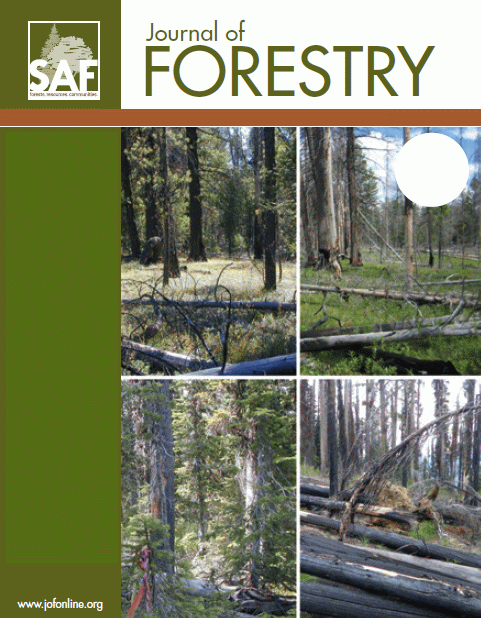
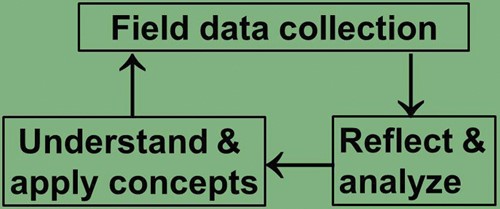
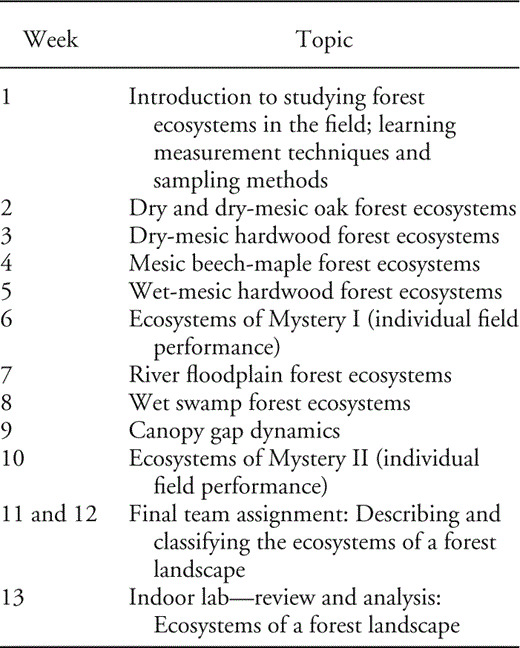
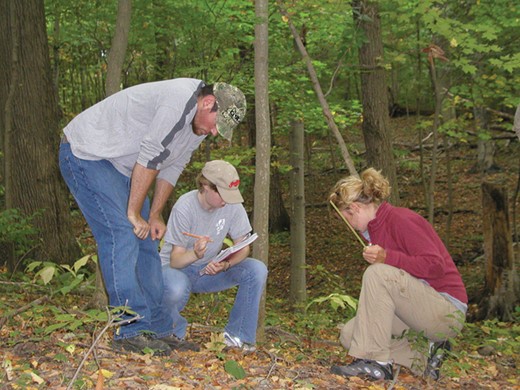
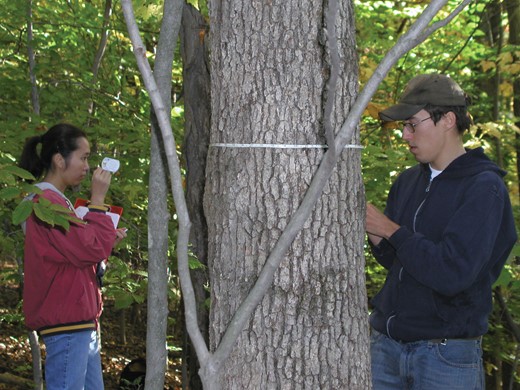

Comments